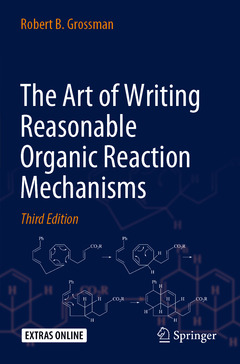Description
The Art of Writing Reasonable Organic Reaction Mechanisms (3rd Ed., 3rd ed. 2019)
Author: Grossman Robert B.
Language: English
Subjects for The Art of Writing Reasonable Organic Reaction Mechanisms:
Approximative price 52.74 €
In Print (Delivery period: 15 days).
Add to cartPublication date: 01-2021
435 p. · 15.5x23.5 cm · Paperback
Publication date: 12-2019
435 p. · 15.5x23.5 cm · Hardback
Description
/li>Contents
/li>Biography
/li>Comment
/li>
Intended for students of intermediate organic chemistry, this text shows how to write a reasonable mechanism for an organic chemical transformation. The discussion is organized by types of mechanisms and the conditions under which the reaction is executed, rather than by the overall reaction as is the case in most textbooks. Each chapter discusses common mechanistic pathways and suggests practical tips for drawing them. Worked problems are included in the discussion of each mechanism, and "common error alerts" are scattered throughout the text to warn readers about pitfalls and misconceptions that bedevil students. Each chapter is capped by a large problem set.
Chapter 1. The Basics.
1. Structure and Stability of Organic Compounds
o Conventions of Drawing Structures; Grossman's Rule
o Lewis Structures; Resonance Structures
o Molecular Shape; Hybridizationo Aromaticity
2. Bronsted Acidity and Basicity
o pKa Values
o Tautomerism
3. Kinetics and Thermodynamics
4. Getting Started at Drawing a Mechanism5. Classes of Overall Transformations
6. Classes of Mechanisms
o Polar Mechanisms
§ Nucleophiles
§ Electrophiles and Leaving Groups
§ Acidic and Basic Conditions; The pKa Rule
§ A Typical Polar Mechanism
o Free-Radical Mechanisms
o Pericyclic Mechanisms
o Transition-Metal-Catalyzed and -Mediated Mechanisms
7. Summary
8. End of Chapter Problems
Chapter 2. Polar Reactions under Basic Conditions.
1. Introduction to Substitution and Elimination
o Substitution by the SN2 Mechanism
o β-Elimination by the E2 and E1cb Mechanismso Predicting Substitution vs. Elimination
2. Addition of Nucleophiles to Electrophilic π Bonds
o Addition to Carbonyl Compounds
o Conjugate Addition; The Michael Reaction3. Substitution at C(sp2)–X s Bonds
o Substitution at Carbonyl C
o Substitution at Alkenyl and Aryl C
o Metal Insertion; Halogen–Metal Exchange
4. Substitution and Elimination at C(sp3)–X σ Bondso Substitution by the SRN1 Mechanism
o Substitution by the Elimination–Addition Mechanism
o Substitution by the One-Electron Transfer Mechanism
o Metal Insertion; Halogen–Metal Exchangeo α-Elimination; Generation and Reactions of Carbenes
5. Base-Promoted Rearrangements
o Migrations from C to C
o Migrations from C to Oo Migrations from B to C or O
6. Two Multistep Reactions
o The Swern Oxidation
o The Mitsunobu Reaction7. Summary
8. End of Chapter Problems
Chapter 3. Polar Reactions under Acidic Conditions.
1. Carbocations
o Carbocation Stabilityo Carbocation Generation; The Role of Protonation
o Typical Reactions of Carbocations; Rearrangements
2. Substitution and β-Elimination Reactions at C(sp3)–X
o Substitution by the SN1 and SN2 Mechanisms
o Elimination by the E1 Mechanismo Predicting Substitution vs. Elimination
3. Electrophilic Addition to Nucleophilic C=C π Bonds
4. Substitution at Nucleophilic C=C π Bonds
o Electrophilic Aromatic Substitutiono Aromatic Substitution of Anilines via Diazonium Salts
o Electrophilic Aliphatic Substitution
5. Nucleophilic Addition to and Substitution at Electrophilic π Bonds.
o Heteroatom Nucleophileso Carbon Nucleophiles
6. Catalysis Involving Iminium Ions
7. Summary
8. End of Chapter Problems
Chapter 4. Pericyclic Reactions.
1. Introduction
o Classes of Pericyclic Reactions
o Polyene MOs
2. Electrocyclic Reactionso Typical Reactions
o Stereospecificity
o Stereoselectivity
3. Cycloadditionso Typical Reactions
§ The Diels–Alder Reaction
§ Other Cycloadditions
o Regioselectivityo Stereospecificity
o Stereoselectivity
4. Sigmatropic Rearrangements
o Typical Reactionso Stereospecificity
o Stereoselectivity
5. Ene Reactions.
6. SummaryChapter 5. Free Radical Reactions.
1. Free Radicals
o Stability
o Generation from Closed-Shell Species
o Typical Reactionso Chain vs. Nonchain Mechanisms
2. Chain Free-Radical Reactions
o Substitution Reactions
o Addition and Fragmentation Reactions3. Nonchain Free-Radical Reactions
o Photochemical Reactions
o Reductions and Oxidations with Metals
§ Addition of H2 across π Bonds
§ Reduction of C-X Bonds. Reductive Coupling
§ One-Electron Oxidations
o Cycloaromatizations
4. Miscellaneous Radical Reactions
o 1,2-Anionic Rearrangements; Lone-Pair Inversion
o Triplet Carbenes and Nitrenes
5. SummaryChapter 6. Transition-Metal-Mediated and -Catalyzed Reactions.
1. Introduction to the Chemistry of Transition Metals
o Conventions of Drawing Structures
o Counting Electrons
§ Typical Ligands; Total Electron Count§ Oxidation State and d Electron Count
o Typical Reactions
o Stoichiometric vs. Catalytic Mechanisms
2. Addition Reactionso Late-Metal-Catalyzed Hydrogenation and Hydrometallation (Pd, Pt, Rh)
o Hydroformylation (Co, Rh)
o Hydrozirconation (Zr)
o Alkene Polymerization (Ti, Zr, Sc, and others)o Cyclopropanation, Epoxidation, and Aziridination of Alkenes (Cu, Rh, Mn, Ti)
o Dihydroxylation and Aminohydroxylation of Alkenes (Os)
o Nucleophilic Addition to Alkenes and Alkynes (Hg, Pd)
o Conjugate Addition Reactions (Cu)o Reductive Coupling Reactions (Ti, Zr)
o Pauson–Khand Reaction (Co)
o Dötz Reaction (Cr)
o Metal-Catalyzed Cycloaddition and Cyclotrimerization (Co, Ni, Rh)3. Substitution Reactions
o Hydrogenolysis (Pd)
o Carbonylation of Alkyl Halides (Pd, Rh)
o Heck Reaction (Pd)
o Metal-Caatalyzed Nucleophilic Substitution Reactions: Kumada, Stille, Suzuki, Negishi, Buchwald–Hartwig, Sonogashira, and Ullmann Reactions (Ni, Pd, Cu)
o Allylic Substitution (Pd)
o Pd-Catalyzed Nucleophilic Substitution of Alkenes; Wacker Oxidation
o C–H Activation (Pd, Ru, Rh)
o Tebbe Reaction (Ti)
o Propargyl Substitution in Co–Alkyne Complexes4. Rearrangement Reactions
o Alkene Isomerization (Rh)
o Olefin and Alkyne Metathesis (Ru, W, Mo, Ti)
5. Elimination Reactionso Oxidation of Alcohols (Cr, Ru)
o Decarbonylation of Aldehydes (Rh)
6. Summary
7. End of Chapter Problems
Chapter 7. Mixed Mechanism Problems.
Chapter level solution manuals are available on SpringerLink as Supplementary Material
Ideal as an independent study guide or reference to organic chemistry
Helps readers develop the ability to distinguish between diverse reactions
Includes common error alerts that warns of pitfalls and misconceptions
Begins with all the basics of the structure and stability of organic compounds
These books may interest you

Organic Chemistry 83.98 €



